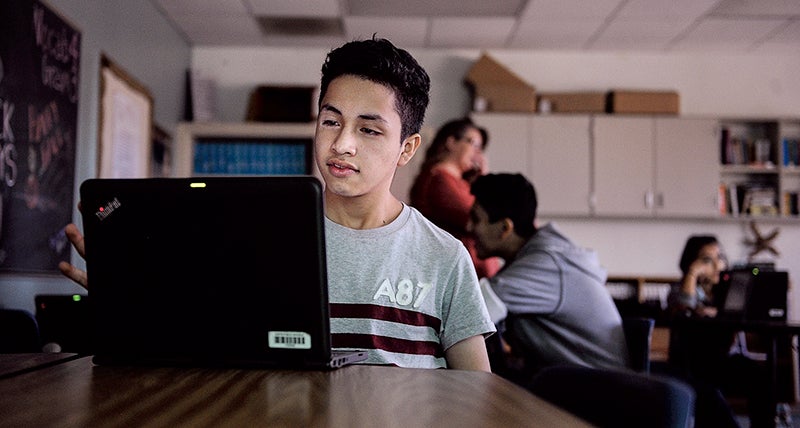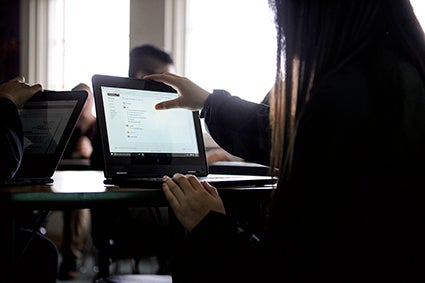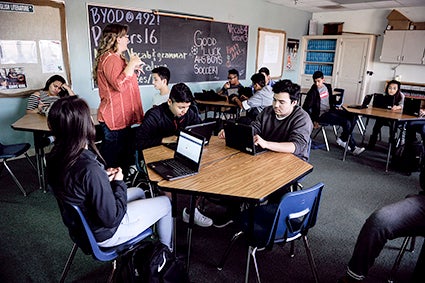Getting a digital leg up; Laptop rollout hits high marks at AHS
Published 10:57 am Friday, October 21, 2016

- Sophomore Felipe Quetzecua uses a school-supplied laptop, part of Austin High School’s One-to-One Laptop Initiative. Eric Johnson/photodesk@austindailyherald.com
When Austin High School physical education teacher Jennifer Stensrud recently found herself with a broken whistle, students quickly found her a replacement.
Or, should we say, they created one.
With a few keystrokes and a 3-D printer, students used their computer savvy to “print” a new whistle.
“Made out of plastic, with a ball inside,” emphasized AHS Principal Katie Baskin. “I know, right? This is far different than from what you and I would think of when we think of computers. It is amazing what students and our staff are doing.”
Welcome to the first year of the One-to-One Laptop Initiative at AHS. This fall, 80 percent of the grade 9-12 student population received a Lenovo laptop for use in classes and at home; the remaining 20 percent, by choice, bring their own laptops to school. With expansion of the initiative to AHS, all of the district’s students in grades five to 12 now have the laptop computers.

Eighty percent of ninth through 12th-graders now have laptops they can use both at school and at home.
EricJohnson/photodesk@austindailyherald.com
Planning
While the high school students received their laptops a couple of months ago, planning for the rollout has spanned previous years.
Since they were already in use at I.J. Holton Intermediate and Ellis Middle schools, some things were already known, and use at the high school was piloted a year ago in preparation for the new devices.
In addition, staff receives weekly training to optimize the ways computers can enhance student learning. Two instructors are on special assignments to help that happen: Amy Thuesen is a technology integrationist and Alexa Dolan Peterson is an instructional coach. Together, they work with staff to implement the use of technology into different subjects.
Burke Egner, the district’s technology director, has a staff that also makes sure the devices are running smoothly. Lenovo was chosen as the supplier due to its emphasis on rugged construction and smart design, he said.
Training and integration
The laptops are getting high marks from both teachers and students. Egner said ideas have exploded in the classrooms and have “made me and my staff a lot busier; we’re having trouble keeping up.” He said some infrastructure had to change to accommodate the increased usage.
“But this is a great problem to have,” he said.
Baskin said the devices have sparked different ways of looking at instruction.
“We are grounded in instruction first, with technology supporting that instruction,” Baskin said. “The laptops are a tool for our students, just one more way to break down barriers to learning.”
There is an emphasis on professional development. Teachers are given opportunities before and after school every week to meet with Thuesen and Dolan Peterson to ask questions, listen to suggestions or pitch ideas for integrating laptop use to a certain lesson or program.
Teachers have embraced their use and the enthusiasm crosses all ages, Baskin said. She gets a kick out of hearing about music students who create audio files of lessons and send them to their instructor rather than having to set aside practice time with the teacher, as was the old practice. Art students have also used the 3-D printer to add dimension to their creations; students have also used the printer to create “fidgets” for special needs students. The small toys help to calm students, which in turn helps them focus for learning.
Such interaction helps strengthen students’ critical thinking skills, which are important for future careers, Baskin said. It also allows students to witness real life experience when there is a problem, or a new idea for programming actually fails.
“It’s a good educational risk and students are fine with that,” Baskin said. “Computers are a tool for engagement, collaboration and learning. Not succeeding is another way to learn too.”

Sophomores in the English Arts class get their laptops out to begin looking at an upcoming project.
EricJohnson/photodesk@austindailyherald.com
Cost
The district pays an average of about $600,000 a year for the machines that go to fifth and ninth graders and whose cost is paid by district dollars and The Hormel Foundation.
The student’s $35 per year fee for the laptop off-sets repair costs, Egner added.
Egner said the district opted to provide “self-maintenance” for the computers, so that he and his staff are certified to work to repair the laptops when needed. That saves time and money since the devices do not have to be sent to the company for the work. Usually, they can turn a repair around in just a few days. Overall, he said, students have taken good care of their computers.
What students think
Senior Cale Richards, 17, is a member of a student technology group that not only is enrolled in an elective technology course, but helps peers with the use of the computers.
The reaction from students, he said, “has been really positive … and getting a $700 computer for $35 seems pretty nice,” and is attractive to students.
More importantly, use of the laptops helps with a number of classes, from writing papers and taking notes to being able to read online texts and have multiple resources at your fingertips.
Michael Vuong, a junior, said use of the laptops frees up time for more study. The laborious task of note-taking is mostly gone since a teacher can post notes for everyone to see at the same time.
“And getting assignments, too,” he said, adding that if you miss a class, assignments can be easily sent to a student.
“And, ultimately, it helps prepare you for college” since laptop use is common there, said Vuong.
The high school laptops are gifted to the students at the end of four years. There are two rollouts now every year, for the fifth grade and for the ninth grade students.
Initially, it was thought the district would adopt a Bring Your Own Laptop to school policy.
However, after studying the issue, it was clear that some students needed help in securing laptops. Today, 80 percent of the high school population uses the program’s laptops. Baskin said the school works with parents who face financial difficulties in paying the annual fee.
“No student who wants a laptop is without a laptop,” she said.





